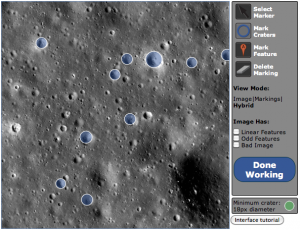This might sound redundant: Craters are simple, circular shapes, and they all pretty much look the same. Can’t computers figure this out easily?
The answer is “no” and the reason is that the brain is a wonderful tool that is excellent at pattern recognition. We see patterns and things that look alike where none exist (remember that bunny rabbit in the clouds?), and we see the overall structure more easily than we see fine details. That’s why human recognition of craters has remained – after over four centuries – better than anything else.
Automated computer algorithms to find craters in image data have been developed for decades. Despite their long history, they still are – at their best – only about 80% accurate, and that’s in the regions that they were specifically written to analyze and were trained in. In general, we expect them to be maybe 70% accurate. But, they are usually much faster than manual human identification.
For some applications, that’s okay. Say you have a spacecraft descending on an asteroid and you want it to quickly identify all potential landing hazards – like boulders or deep craters – and adjust its course. In cases like that, you don’t care about whether or not the code can find that highly degraded crater that you can barely see. You just want the obvious ones.
But in other applications, that’s not good enough. That’s where you come in.
Let’s face it: The moon has roughly half a million craters that are about 1 km in diameter or larger. Those are about the biggest craters we’re currently looking for in Moon Mappers. If you go smaller, let’s just say 100 meters in diameter (in Moon Mappers, we’re asking you to find craters larger than about 10 meters), there are probably about half a billion. Then expand that to other surfaces, like Mercury, Mars, asteroids, and outer solar system moons. It’s not possible for us to find them all manually. We have to use automated software because it’s faster.
But we can still ask you to spot-check for us. And we can give you regions with craters detected with different automated codes and test which parameters work best, and we can also provide feedback to developers of these codes to help them tweak them in the future.
That’s the purpose behind the Man vs Machine task. We give you image slices just like in the regular crater identification task, but we already have the craters on there from the automated code. We then ask you to fix the mistakes (position and size), identify craters that were missed, and remove completely wrong ones.
Human brains are better than our machine code. But how much better? Take the Man vs Machine challenge so we can find out!





 Join the Crew!
Join the Crew!
 Escape Velocity Space News
Escape Velocity Space News
0 Comments